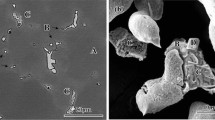Conclusions
The addition of silicon has a refining effect on a tungsten-copper pseudoalloy and improves its properties. Some increase in the strength and ductility of the alloy is observed. A silicon addition changes the character of fracture of the pseudoalloy from interto transgranular. The effect of a zirconium addition on the properties of the pseudoalloy is less than that of a silicon addition.
Similar content being viewed by others
Literature cited
K. Krock, “Inorganic powder composites,” in: Modern Composite Materials [Russian translation], Mir, Moscow (1970), pp. 555–583.
V. N. Eremenko, Yu. V. Naidich, and I. A. Lavrinenko, Sintering in the Presence of a Liquid Metallic Phase [in Russian], Naukova Dumka, Kiev (1969).
V. V. Gorskii, N. D. Lesnik, R. V. Minakova, et al., “Effects of titanium and zirconium upon the formation and properties of W-Cu pseudoalloys,” Poroshk. Metall., No. 5, 53–60 (1975).
D. M. Karpinos, A. A. Kravchenko, Yu. L. Pilipovskii, et al., “Mechanical characteristics of hot-pressed tungsten-copper pseudoalloys,” Probl. Prochn., No. 12, 64–69 (1970).
M. L. Bernshtein and V. A. Zaimovskii, Mechanical Properties of Metals [in Russian], Metallurgiya, Moscow (1979).
Yu. V. Naidich, “Adhesion and wetting of nonmetallic solids by liquid metals,” in: Surface Phenomena in Melts and in Solid Phases Forming from Them [in Russian], Kabardino-Balkarsk Book Press, Nalchik (1965), pp. 30–38.
V. N. Eremenko and Yu. V. Naidich, Wetting of Solid Refractory Compounds by Liquid Metals [in Ukrainian], Izd. Akad. Nauk Ukr. SSR, Kiev (1958).
V. I. Trefilov, Yu. M. Mil'man, and S. A. Firstov, Physical Principles of the Strength of Refractory Metals [in Russian], Naukova Dumka, Kiev (1975).
S. F. Ramseyer and E. A. Steigerwald, “Influence of infiltrant properties on the strength of tungsten-copper composites,” Trans. Metall. Soc. AIME,233, No. 1, 260–268 (1965).
Author information
Authors and Affiliations
Additional information
Translated from Poroshkovaya Metallurgiya, No. 3(231), pp. 101–105, March, 1982.
The author wishes to thank Dr. S. A. Firstov' for helpful discussion.
Rights and permissions
About this article
Cite this article
Sirotyuk, M.M., Smirnov, V.P., Panichkina, V.V. et al. Fractographic study of a tungsten-copper pseudoalloy. Powder Metall Met Ceram 21, 247–250 (1982). https://doi.org/10.1007/BF00791693
Received:
Issue Date:
DOI: https://doi.org/10.1007/BF00791693




